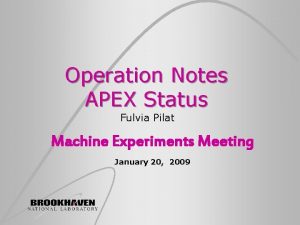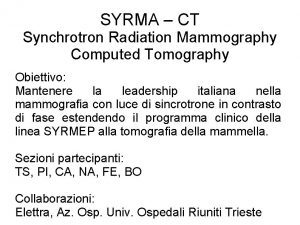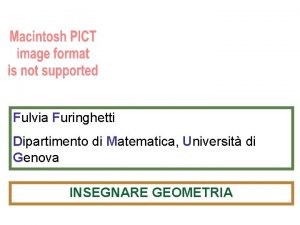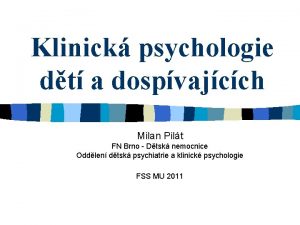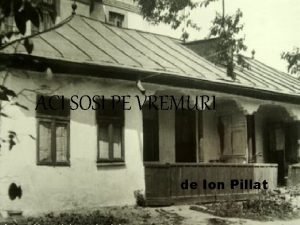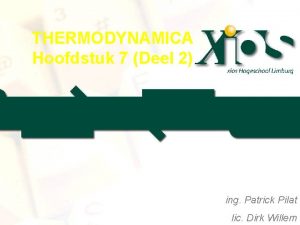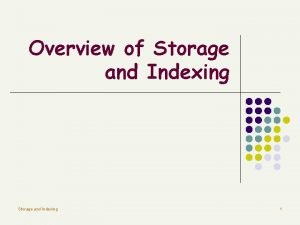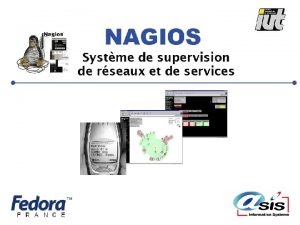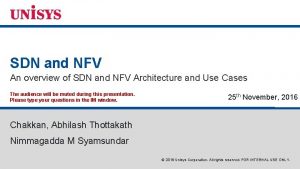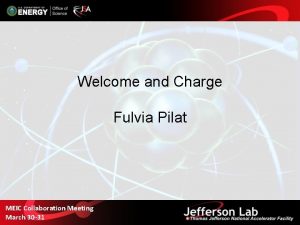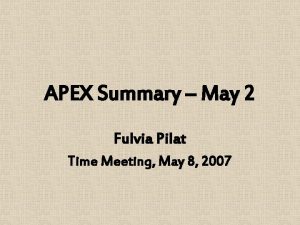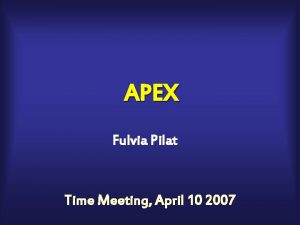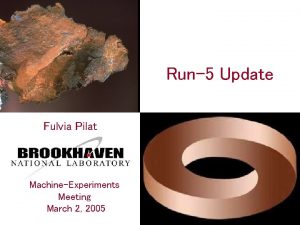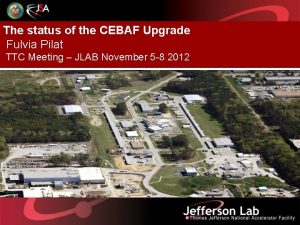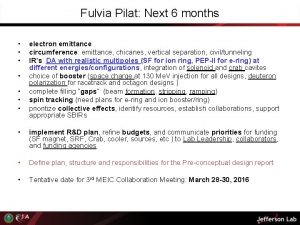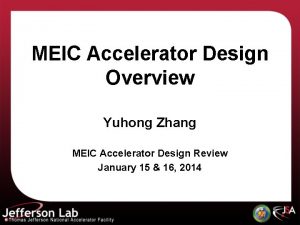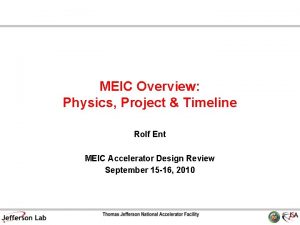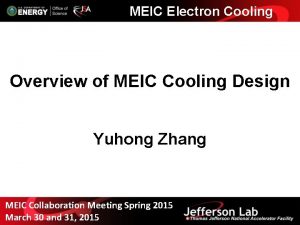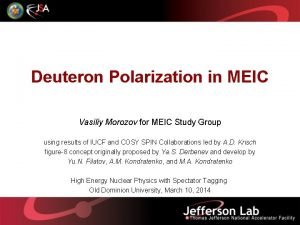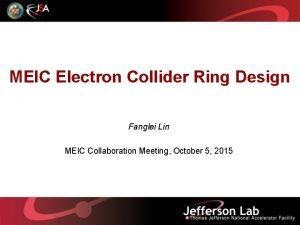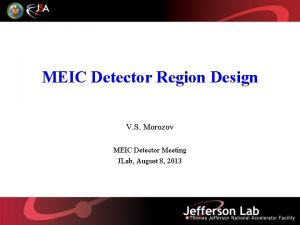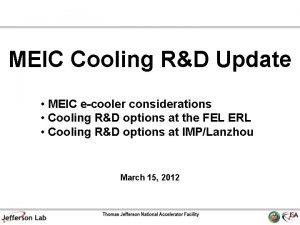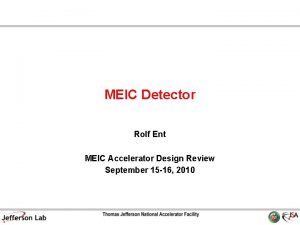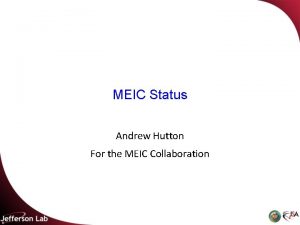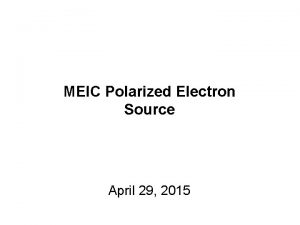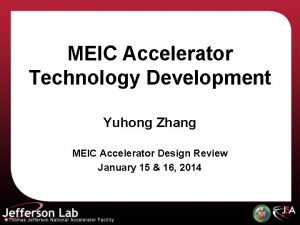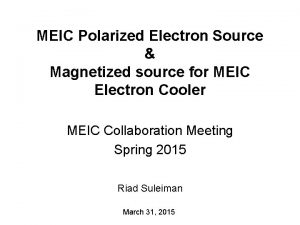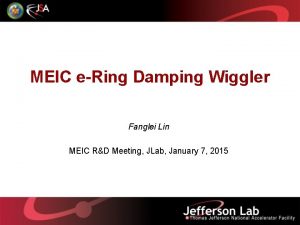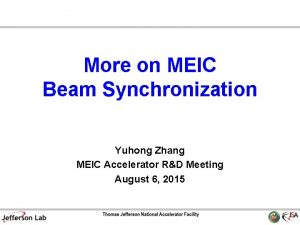MEIC Overview and PreProject RD Fulvia Pilat MEIC


































- Slides: 34

MEIC Overview and Pre-Project R&D Fulvia Pilat MEIC Collaboration Meeting March 30 -31

Outline • Design strategy for the EIC at JLAB • Design optimization (cost, performance and potential for upgrade) • MEIC baseline • Machine performance • R&D: pre-project and on-project • Conclusions 2

MEIC Design Goals Energy Full coverage of √s from 15 to 65 Ge. V Electrons 3 -10 Ge. V, protons 20 -100 Ge. V, ions 12 -40 Ge. V/u Ion species Polarized light ions: p, d, 3 He, and possibly Li Un-polarized light to heavy ions up to A above 200 (Au, Pb) Space for at least 2 detectors Full acceptance is critical for the primary detector Luminosity 1033 to 1034 cm-2 s-1 per IP in a broad CM energy range Polarization At IP: longitudinal for both beams, transverse for ions only All polarizations >70% Upgrade to higher energies and luminosity possible 20 Ge. V electron, 250 Ge. V proton, and 100 Ge. V/u ion Design goals consistent with the White Paper requirements 3

Design Strategy: High Luminosity • The MEIC design concept for high luminosity is based on high bunch repetition rate CW colliding beams KEK-B already reached above 2 x 1034 /cm 2/s Beam Design • High repetition rate • Low bunch charge • Short bunch length • Small emittance IR Design • Small β* • Crab crossing Damping • Synchrotron radiation • Electron cooling “Traditional” hadrons colliders Small number of bunches è Small collision frequency f è Large bunch charge n 1 and n 2 è Long bunch length è Large beta-star Linac-Ring colliders • Large beam-beam parameter for the electron beam • Need to maintain high polarized electron current • High energy/current ERL 4

Design strategy: High Polarization All rings are figure-8 critical advantages for both ion and electron beam § Spin precessions in the left & right parts of the ring are exactly cancelled § Net spin precession (spin tune) is zero, thus energy independent § Spin is easily controlled and stabilized by small solenoids or other compact spin rotators Advantage 1: Ion spin preservation during acceleration § Ensures spin preservation § Avoids energy-dependent spin sensitivity for all species of ions § Allows a high polarization for all light ion beams Advantage 2: Ease of spin manipulation § Delivers desired polarization at the collision points Advantage 3: The only practical way to accommodate polarized deuterons (given the ultra small g-2) Advantage 4: Strong reduction of quantum depolarization thanks to the energy independent spin tune. 5

Design Optimization The MEIC goals, strategy and basic design choices (figure-8, B-factory beam structure for high luminosity for e- and ion rings) have NOT changed since 2006 The goal of cost, performance and upgrade optimization led us to the following implementation: 1. A circumference of ~2. 2 km will allow: • Re-use of the PEP-II machine for the electron ring and e- transfer lines • Use of super-ferric magnets for the ion ring instead of cos-q superconducting magnets 2. Only one booster needed, accelerating from 285 Me. V to 8 Ge. V EIC Cost Review - January 26 -28, 2015 6

Baseline Layout Warm Electron Collider Ring (3 to 10 Ge. V) Linac I on Sour c Booster e Booster Linac Ion Source CEBAF is a full energy injector. Only minor gun modification is needed MEIC Cost Review December 18 2014 7

Campus Layout ~2. 2 km circumference E-ring from PEP-II Ion-ring with superferric magnets Tunnel consistent with a 250+ Ge. V upgrade 8

MEIC Baseline for the cost estimate § Collider ring circumference: ~2200 m § Electron collider ring and transfer lines : PEP-II magnets, RF (476 MHz) and vacuum chambers § Ion collider ring: super-ferric magnets § Booster ring: super-ferric magnets § SRF ion linac Energy range § Electron: § Proton: § Lead ions: Design point 3 to 10 Ge. V 20 to 100 Ge. V up to 40 Ge. V p energy (Ge. V) e- energy (Ge. V) Main luminosity limitation low 30 4 space charge medium 100 5 beam high 100 10 synchrotron radiation 9

MEIC Electron Complex • CEBAF provides up to 12 Ge. V, high repetition rate and high polarization (>85%) electron beams, no further upgrade needed beyond the 12 Ge. V CEBAF upgrade. • Electron collider ring design § § § § Beam characteristics • 3 A beam current at 6. 95 Ge. V Normalized emittance 1093 mm @ 10 Ge. V Synchrotron radiation power density 10 k. W/m total power 10 MW @ 10 Ge. V Dx(m) § § x(m), y(m) • circumference of 2154. 28 m = 2 x 754. 84 m arcs + 2 x 322. 3 m straights Meets design requirements Provides longitudinal electron polarization at IP(s) IP incorporates forward electron detection Electron Collider Ring Optics accommodates up to two detectors includes non-linear beam dynamics reuses PEP-II magnets, vacuum chambers and RF CEBAF and the electron collider provide the required electron beams for the EIC. 10

Electron collider ring w/ major machine components Sp in ro tat or R= 1 55 m T St une r a ig trom h t FO bo DO ne s & in Sp or tat Future 2 nd IP RF Sp r to ta ro ro B CC e- 81. 7 Arc, 261. 7 RF in Sp in IP rot at or Forward e- detection Circumference of 2154. 28 m = 2 x 754. 84 m arcs + 2 x 322. 3 m straights Figure-8, crossing angle 81. 7 11 Electron Collider Ring Layout

Electron Ring Optics Parameters Electron beam momentum Ge. V/c 10 m 2154. 28 Arc net bend deg 261. 7 Straights’ crossing angle deg 81. 7 Arc/straight length m 754. 84/322. 3 Beta stars at IP *x, y cm 10/2 Detector space m -3 / 3. 2 Maximum horizontal / vertical functions x, y m 949/692 Maximum horizontal / vertical dispersion Dx, y m 1. 9 / 0 Circumference Horizontal / vertical betatron tunes x, y 45. (89) / 43. (61) Horizontal / vertical chromaticities x, y -149 / -123 Momentum compaction factor 2. 2 10 -3 Transition energy tr Horizontal / vertical normalized emittance x, y Maximum horizontal / vertical rms beam size x, y 21. 6 µm rad 1093 / 378 mm 7. 3 / 2. 1 12

CEBAF - Full Energy Injector CEBAF fixed target program – 5 -pass recirculating SRF linac – Exciting science program beyond 2025 – Can be operated concurrently with the MEIC CEBAF will provide for MEIC – – Up to 12 Ge. V electron beam High repetition rate (up to 1497 MHz) High polarization (>85%) Good beam quality up to the m. A level 13

Ion Collider Ring with Super-Ferric Magnets ~2. 2 km circumference to match PEP-II-magnet-based electron ring Super-ferric magnets for the ion collider ring ~3 T maximum field, 4. 5 K operating temperature Cost effective, construction and operation ( factor of ~2 cheaper to operate, GSI) Maximum proton momentum of 100 Ge. V/c The lattice is based on a FODO cell length of 22. 8 (1. 5 x PEP-II FODO cell) optimized for an 8 m long SF dipole magnet The lattice is fully matched 14

Ion Collider Ring Figure-8 ring with a circumference of 2153. 9 m Two 261. 7 arcs connected by two straights crossing at 81. 7 p. / #2 p. su atch p s di. m om ge ge om disp. . m sup atc p. h# / 3 no r SR m. + F. lec Arc, 261. 7 l. oo ne + tu mb. h tro atc m c e 81. 7 . lem p. . e t de ions / pp. u s. 1 disp atch #. m m o ge p. / ex am ch be mat . p dis 5 R=1 future 2 nd IP p su IP dis om p. su. m pp. atc / h# 3 ge 15 5. 5 m

Ion Collider Ring Parameters All design goals achieved Proton energy range Polarization Detector space Luminosity Ge. V % m cm-2 s-1 20(8)-100 > 70 -4. 6 / +7 > 1033 m deg cm m m 2153. 89 81. 7 10 / 2 ~2500 3. 28 24(. 38) / 24(. 28) -101 / -112 6. 45 10 -3 12. 46 0. 35 / 0. 07 ~20 / ~4 2. 8 / 1. 3 Resulting collider ring parameters Circumference Straights’ crossing angle Horizontal / vertical beta functions at IP *x, y Maximum horizontal / vertical beta functions x, y max Maximum horizontal dispersion Dx Horizontal / vertical betatron tunes x, y Horizontal / vertical natural chromaticities x, y Momentum compaction factor Transition energy tr Normalized horizontal / vertical emittance x, y Horizontal / vertical rms beam size at IP *x, y Maximum horizontal / vertical rms beam size x, y µm rad µm mm 16

MEIC super-ferric dipole • 2 X 4 m long dipole • Nb. Ti cable • 3 T • Correction sextupole • Common cryostat 17

MEIC super-ferric Quadrupole Arc quads Matching quads FF triplets EIC Cost Review - January 26 -28, 2015 ~50 T/m SF ~80 T/m SF cos-q 18

Ion Injector Complex - Overview Booster (8 Ge. V) (accumulation) DC e-cooling Ion Sources SRF Linac (285 Me. V) Status of the ion injector complex: § Relies on demonstrated technology for injectors and sources § Design for an SRF linac exists § 8 Ge. V Booster design to avoid transition for all ion species and based on super-ferric magnet technology § Injection/extraction lines to/from Booster are designed 19

MEIC Multi-Step Cooling Scheme ion sources ion linac BB cooler DC cooler collider ring (8 to 100 Ge. V) Booster (0. 285 to 8 Ge. V) Ring Booster ring Collider ring Cooler DC Function Ion energy Electron energy Ge. V/u Me. V 0. 11 ~ 0. 19 (injection) 0. 062 ~ 0. 1 2 1. 1 Maintain emittance during stacking 7. 9 (injection) 4. 3 Maintain emittance Up to 100 Up to 55 Injection/accumulation of positive ions Emittance reduction Bunched Beam Cooling (BBC) § DC cooling for emittance reduction § BBC cooling for emittance preservation 20

Performance MEIC baseline Achieved with a single pass ERL cooler For a full acceptance detector CM energy Ge. V Beam energy Collision frequency Particles per bunch Beam current Polarization Bunch length, RMS Norm. emitt. , vert. /horz. Horizontal and vertical β* Ge. V MHz 1010 A % cm μm cm 21. 9 (low) p e 30 4 476 0. 66 3. 9 0. 5 3 >70% 2. 5 1. 2 0. 5/0. 5 74/74 3 5 Vert. beam-beam param. 0. 01 Laslett tune-shift Detector space, up/down Hour-glass (HG) reduction Lumi. /IP, w/HG, 1033 0. 054 7/3. 6 m cm-2 s 1 0. 02 small 3. 2 / 3 0. 89 1. 9 44. 7 (medium) p E 100 5 476 0. 66 3. 9 0. 5 3 >70% 1 1. 2 1/0. 5 144/72 2/4 2. 6/1. 3 63. 3 (high) p e 100 10 159 2. 0 2. 8 0. 5 0. 72 >70% 2. 5 1. 2/0. 6 1152/576 5/2. 5 2. 4/1. 2 0. 006 0. 014 0. 002 0. 01 7/3. 6 small 3. 2 / 3 0. 01 7/3. 6 0. 88 4. 6 0. 013 small 3. 2 / 3 (3) 0. 73 1. 0 For a high(er) luminosity detector Horizontal and vertical β* cm Vert. beam-beam param. Detector space, up/down Hour-glass (HG) reduction Lumi. /IP, w/HG, 1033 m cm-2 s 1 1. 2 2 1. 6 / 0. 8 2 /1 1. 6 / 0. 8 0. 01 0. 02 0. 004 0. 021 0. 001 0. 021 ± 4. 5 3 0. 67 3. 5 0. 74 7. 5 0. 58 1. 4 21

e-p Luminosity (1033 cm-2 s 1034 12 A full acceptance detector 1034 10 (baseline) A high luminosity detector 8 6 4 2 0 1033 20 30 40 50 60 70 CM energy (Ge. V) The baseline performance requires a ERL bunched beam cooler but no circulator cooler 22

e-ion luminosity For a full acceptance detector Electron e 5 3. 9 3 >70% 1. 2 144/72 2. 6/1. 3 0. 014 Proton P 100 0. 66 0. 5 >70% 1 1/0. 5 4/2 0. 006 0. 01 Deuteron d 50 0. 66 0. 5 > 70% 1 0. 5/0. 25 4/2 0. 006 0. 041 0. 89 Helium Carbon 3 He++ 12 C 6+ 66. 7 50 0. 33 0. 11 0. 5 > 70% 1 1 0. 7/0. 35 0. 5/0. 25 4/2 0. 006 0. 022 0. 041 7 / 3. 6 0. 89 Calcium 40 Ca 20+ 50 0. 033 0. 5 1 0. 5/0. 25 4/2 0. 006 0. 041 Lead 39. 4 0. 008 0. 5 1 0. 5/0. 25 5/2. 5 0. 005 0. 041 0. 89 208 Pb 82+ Beam energy Particles/bunch Beam current Polarization Bunch length, RMS Norm. emit. , horz. /vert. β*, hori. & vert. Vert. beam-beam parameter Laslett tune-shift Detector space Hour-glass (HG) reduction factor Ge. V 1010 A Lumi/IP/nuclei, w/ HG correction 1033 cm-2 s-1 4. 6 2. 2 0. 77 0. 23 0. 04 Lumi/IP/nucleon, w/HG correction, 1033 cm-2 s-1 4. 6 9. 2 6. 6 9. 2 7. 8 1. 6/0. 8 0. 004 cm μm cm m 3. 2 / 3 For a high(er) luminosity detector β*, hori. & vert. Vert. beam-beam parameter Detector space Hour-glass (HG) reduction factor cm Lumi/IP/nuclei, w/ HG correction m 1. 6/0. 8 0. 02 3 4. 5 0. 74 1033 cm-2 s-1 7. 5 9. 3 3. 7 1. 37 0. 38 0. 08 Lumi/IP/nucleon, w/HG correction, 1033 cm-2 s-1 7. 5 15. 1 11. 1 15. 1 17. 3 23

Overview R&D for the MEIC baseline Needed R&D Risk level Mitigating strategies Mitigated risk level Bunched beam electron cooling ERL only MEDIUM § Test of bunched beam cooling at IMP (LDRD) § Experience from RHIC low energy cooling § Development of a 200 m. A unpolarized e- gun LOW Low * ion ring MEDIUM § Chromatic and IR nonlinear correction schemes § DA tracking with errors and beam § Operational experience at hadron colliders LOW Space charge dominated beams MEDIUM § Simulation § DC cooling in Booster § Operational experience at UMER and IOTA rings § Study of space charge compensation at e. RHIC LOW Figure 8 layout MEDIUM § Spin tracking simulations LOW Super ferric magnets MEDIUM § Existing prototypes (SSC, GSI) § Early MEIC prototype (FY 15 -16) § Operational experience at GSI § Alternative cosq designs LOW Crab cavities MEDIUM § Prototypes § Operational experience at KEK-B and LHC § Test of crab cavity in LERF (FEL) LOW SRF R&D LOW § 952 MHz RF development LOW 24

Pre-Project R&D (for CD-1) PROTOTYPES • Development and testing of 1. 2 m 3 T SF magnets for MEIC ion ring and booster Collaboration with Texas A&M, FY 15 -16 • Crab cavity development (collaboration with ODU, leveraging R&D for LHC / LARP crab) • 952 MHz Cavity development, FY 15 -17 DESIGN OPTIMIZATION • Optimization of conceptual design of MEIC ion linac Collaboration with ANL and/or FRIB, FY 15 -17 • Design and simulation of fixed-energy electron cooling ring (integrated in the Ion Ring arc cryostats) to enable cooling and stacking of polarized ions during each store so that a fresh highbrightness fill is ready when needed Collaboration with Texas A&M, FY 15 -17 • Optimization of Integration of detector and interaction region design, detector background, nonlinear beam dynamics, PEP-II components Collaboration with SLAC, FY 12 -17 • Feasibility study of an experimental demonstration of cooling of ions using a bunched electron beam Collaboration with Institute of Modern Physics, China

Pre-Project R&D MODELING • Studies and simulations on preservation and manipulation of ion polarization in a figure-8 storage ring Collaboration with A. Kondratenko, FY 13 -15 • Algorithm and code development for electron cooling simulation, FY 15 -16 We believe that this covers our R&D needs for the CDR and CD 1

On-Project R&D PROTOTYPES • • Prototype for magnetized ERL e-cooler gun 952 MHz prototype cryomodule components Crab cavity prototype cryomodule components Prototype for ion ring IR FF triplet 3 M$ 2 M$ VALUE ENGINEERING (cost and risk reduction) • • Super-ferric Cable-in-Conduit magnets R&D for the ion rings 1. 5 M$ Optimization of of PEP-II components (tubes, LLRF, vacuum) 1. 3 M$ R&D on high-efficiency RF sources 1 M$ Optimization of linac front end components for low duty factor 1 M$ • Total 13. 8 M$

Conclusions and Outlook The MEIC baseline based on a ring-ring design is mature and can deliver luminosity from a few 1033 to a few 1034 and polarization over 70% in the √s 15 -65 Ge. V range with low technical risks. The MEIC baseline fulfills the requirements of the white paper. We continue to optimize the present design for cost and performance. The design can be upgraded in energy and luminosity. 28

Backup Slides EIC Cost Review - January 26 -28, 2015 29

Draft Timeline JSA Science Council 9/18/2014 30

Areas of Design Optimization RF power of the high energy electron beam • • Limit average current, but allow a higher bunch charge Lower bunch repetition rate can increase luminosity as long as the ion space charge is OK Space charge effect for the low energy proton beam • • • Limit bunch charge, but allow higher average current (higher bunch frequency) Increase bunch length to store more charge in a bunch (hour glass effect) Increase the bunch repetition rate Beam-beam effect • Limit bunch charge, but allow higher average current (bunch frequency) Electron emittance • • Due to the large bending angle of PEP-II dipoles and PEP lattice Emittance reduction with damping wiggler and/or TME lattice EIC Cost Review - January 26 -28, 2015 31

Performance Enhancements: energy reach and operations § Raise the e-ring energy to 12 Ge. V by adding more RF to the e-ring (all other e-ring components already consistent with 12 Ge. V) § Raising the ion-ring energy to 120 Ge. V (That requires an increase of the super-ferric magnet field strength by 20%). § Raising the ion-ring energy to >250 Ge. V (a 5. 5 T design for cos-theta RHIClike magnets has been already considered and appears feasible, and we can capitalize on R&D on high field superconducting magnets for the LHC upgrade and beyond). § Modifying the ion ring lattice to avoid transition crossing for all ion species through replacement of present FODO arcs with a newly developed negative momentum compaction optics, which yields imaginary transition gamma for the ion ring. EIC Cost Review - January 26 -28, 2015 32

Performance enhancements: luminosity § Reduce e- emittance: • Reduce growth from spin rotators (new design, -35%) • TME lattice for the e-ring (We have a lattice solution already and it requires swapping a fraction of the PEP-II dipoles with new ones) • Add a damping wiggler Nor. Equilibrium Emittance εx. N (μm) Energy (Ge. V) 5 10 Arc FODO (108 pha. adv. ) 95 759 TME cell 26 204 Arc (FODO + old spin rotators) 128 1026 Arc (TME + 35% less emittance new spin rotators) 48 378 Whole ring (Arcs + IR) 139 1163 Whole ring (Arcs + 35% less emittance IR) 56 467 Whole ring (Arcs + 35% less emittance IR + DW) 40 440 § Reduce the ion emittance by ~factor 3 by adding a circulator cooler to the ERL cooler § Double the repetition rate EIC Cost Review - January 26 -28, 2015 33

MEIC enhanced performance CM energy Ge. V Beam energy Collision frequency Particles per bunch Beam current Polarization Bunch length, RMS Norm. emitt. , vert. /horz. Horizontal and vertical β* Ge. V MHz 1010 A % cm μm cm 21. 9 (low) p e 30 4 952 0. 66 3 1 4. 5 >70% 2. 5 1. 2 0. 45/0. 45 30/30 1/1 3. 7/3. 7 Vert. beam-beam param. 0. 008 Laslett tune-shift Detector space, up/down Hour-glass (HG) reduction Lumi. /IP, w/HG, 1033 0. 061 small 7/3. 6 3. 2 / 3 0. 65 m cm 2 s 1 0. 05 6. 7 44. 7 (medium) p e 100 5 952 0. 66 2. 6 1 4 >70% 0. 7 1 0. 35/0. 07 40/20 5/1 4/0. 8 0. 015 63. 3 (high) p e 100 10 159 2. 0 2. 8 0. 5 0. 72 >70% 2. 75 0. 7 0. 35/0. 07 440/220 7. 5/1. 5 4/0. 8 0. 061 0. 055 small 7/3. 6 3. 2 / 3 0. 86 0. 013 7/3. 6 small 3. 2 /3 0. 65 32. 6 4 About a factor 7 better than the baseline This is for the full acceptance detector EIC Cost Review - January 26 -28, 2015 34
 Fulvia pilat
Fulvia pilat Fulvia pilat
Fulvia pilat Fulvia arfelli
Fulvia arfelli Fulvia furinghetti
Fulvia furinghetti Milan pilát psycholog
Milan pilát psycholog Aci sosi pe vremuri de ion pilat
Aci sosi pe vremuri de ion pilat Volumearbeid
Volumearbeid Perbedaan replikasi virus dna dan rna
Perbedaan replikasi virus dna dan rna Data quality and data cleaning an overview
Data quality and data cleaning an overview The two rows of elements that seem to be disconnected
The two rows of elements that seem to be disconnected An overview of data warehousing and olap technology
An overview of data warehousing and olap technology Multicullar
Multicullar An overview of data warehousing and olap technology
An overview of data warehousing and olap technology Data quality and data cleaning an overview
Data quality and data cleaning an overview Data quality and data cleaning an overview
Data quality and data cleaning an overview Overview of storage and indexing
Overview of storage and indexing Chapter 17 overview elements and their properties
Chapter 17 overview elements and their properties Www stands for world wide web
Www stands for world wide web Maximo work order priority
Maximo work order priority Universal modelling language
Universal modelling language Uml overview
Uml overview Vertical overview
Vertical overview Figure 12-1 provides an overview of the lymphatic vessels
Figure 12-1 provides an overview of the lymphatic vessels Pulmonary circulation diagram
Pulmonary circulation diagram Texas public school finance overview
Texas public school finance overview Walmart company introduction
Walmart company introduction Stylistic overview
Stylistic overview How can we integrate oop with sd/sa ?
How can we integrate oop with sd/sa ? Spring framework overview
Spring framework overview Nagios tactical overview
Nagios tactical overview Market overview managed file transfer solutions
Market overview managed file transfer solutions Nfv vs sdn
Nfv vs sdn Sbic program
Sbic program Sap mm consignment process
Sap mm consignment process Ariba registration process
Ariba registration process

